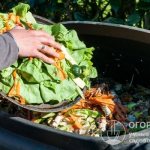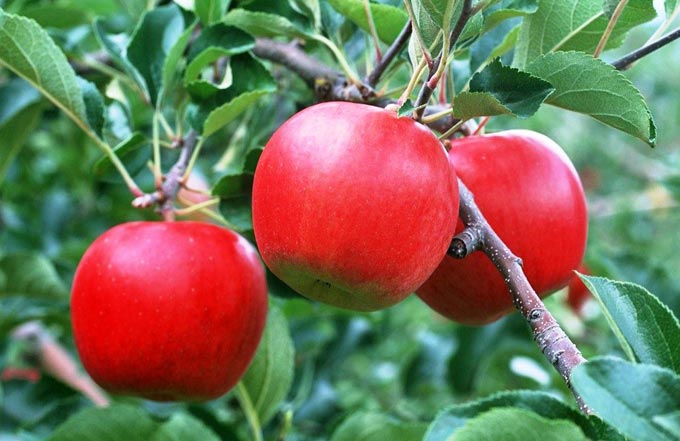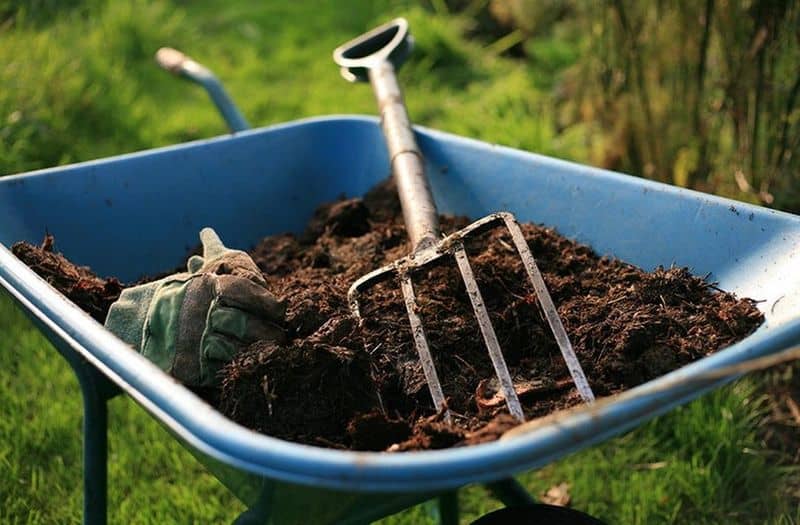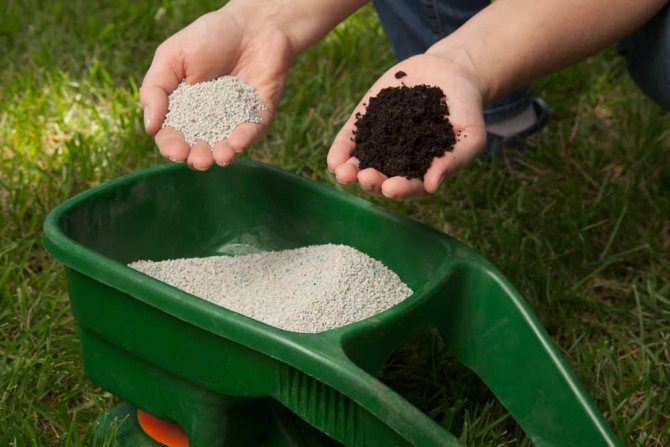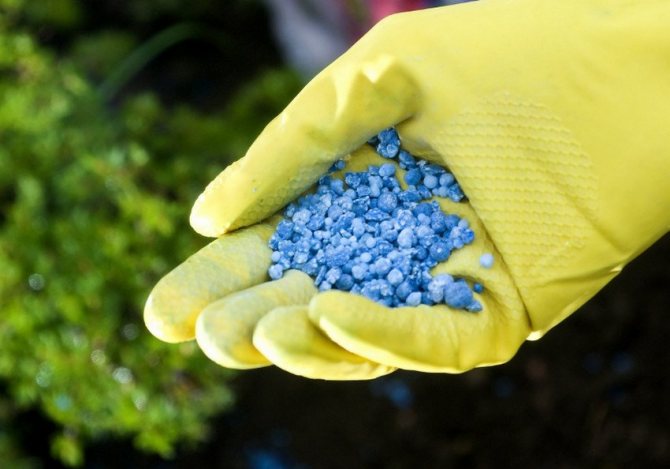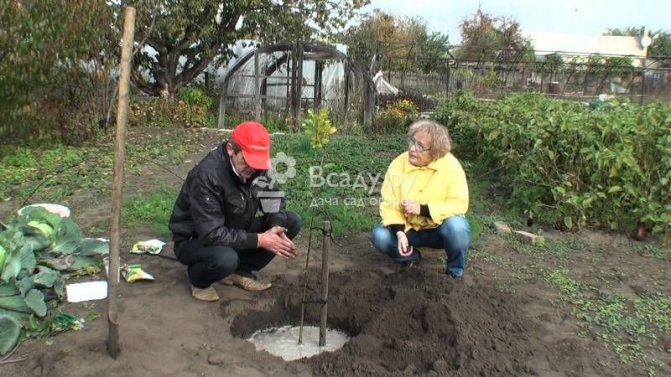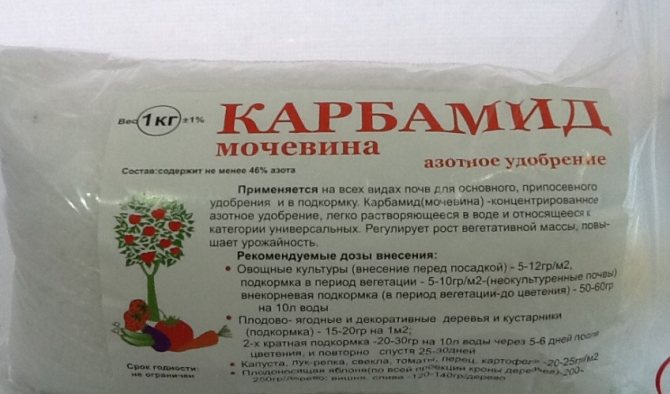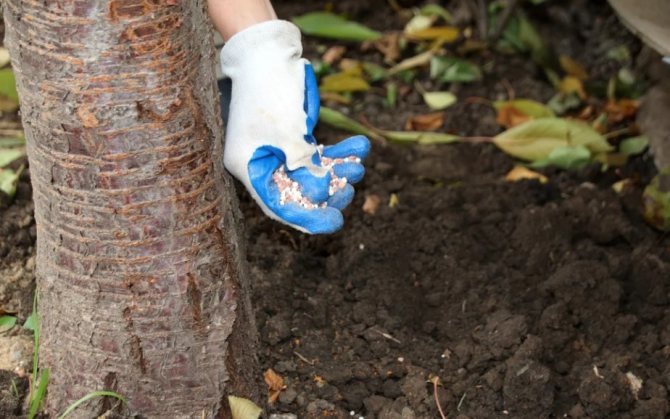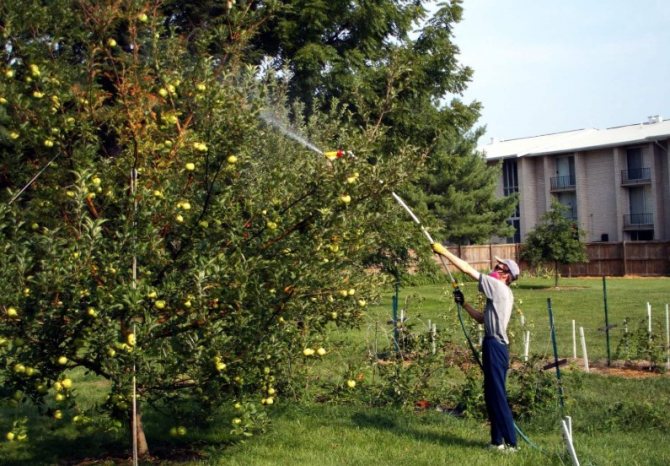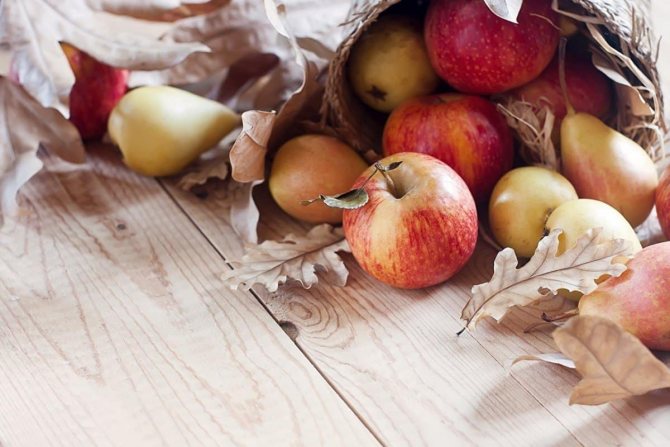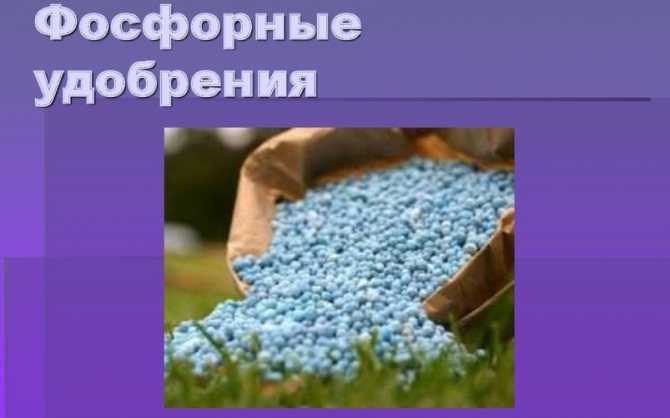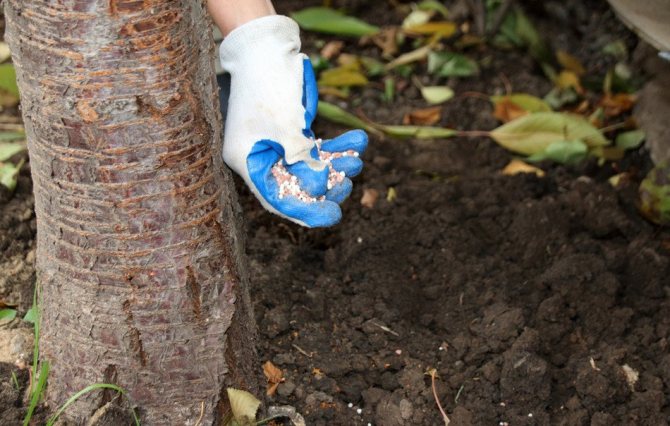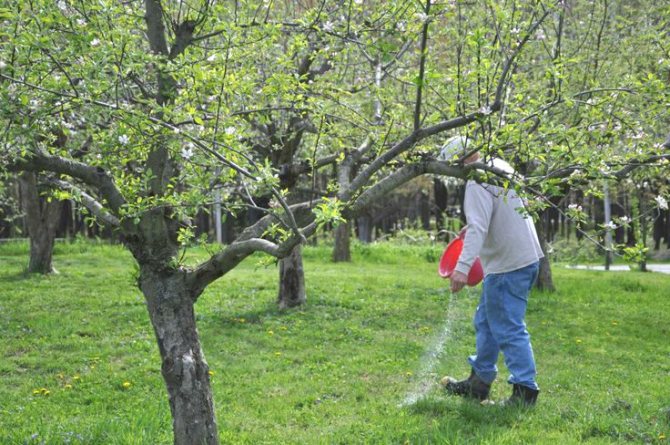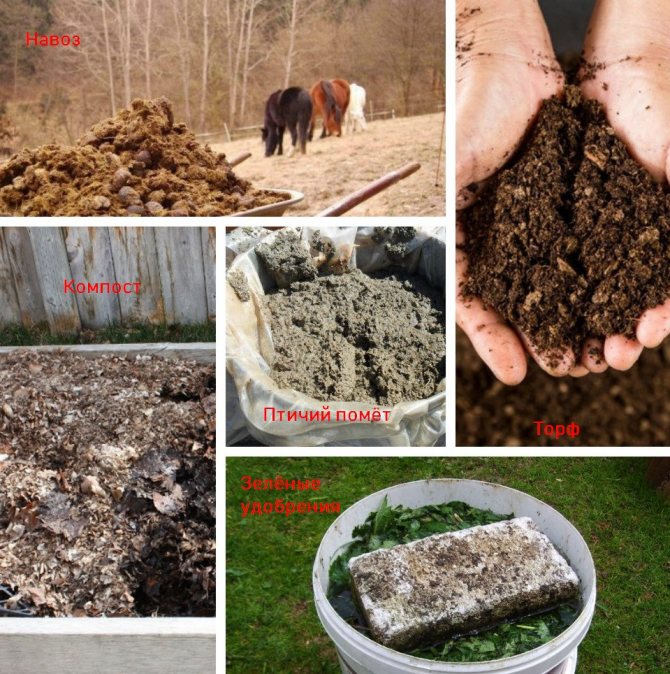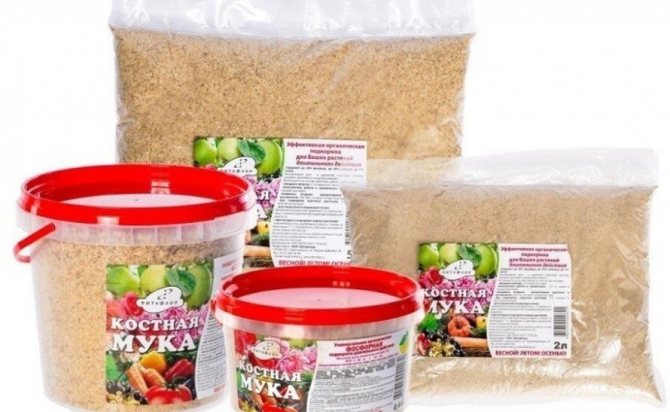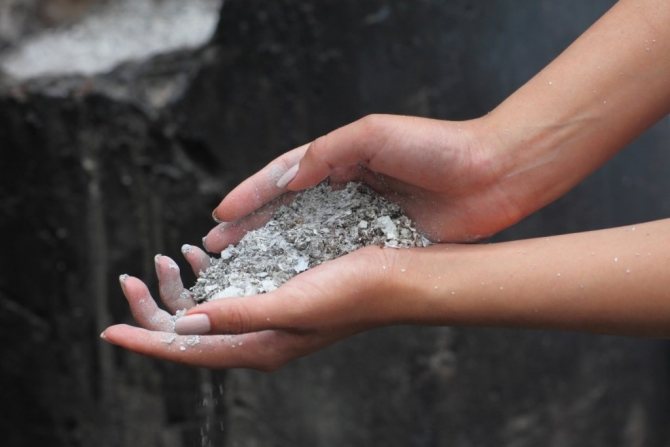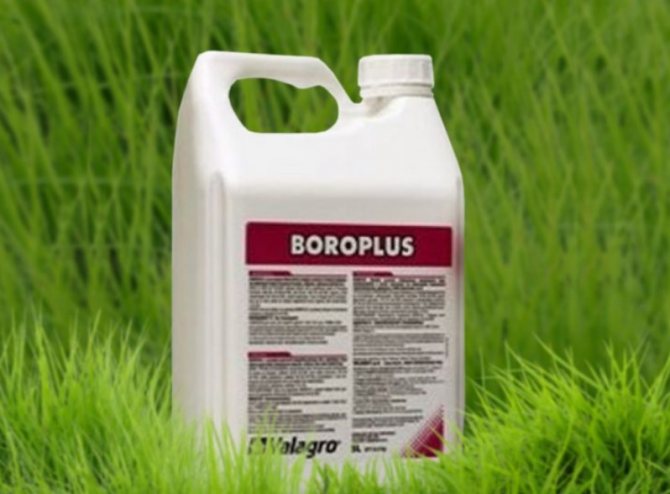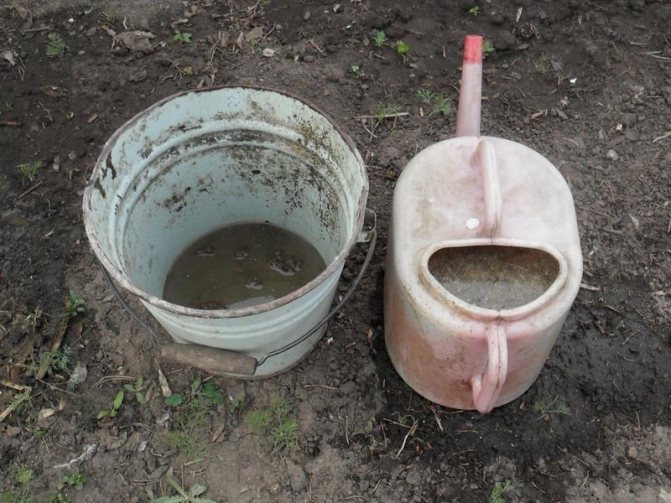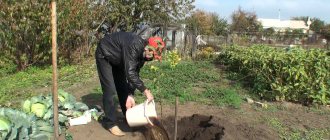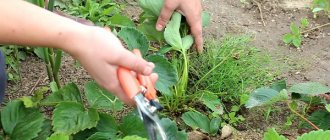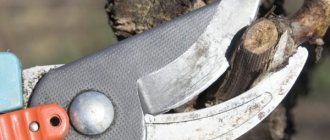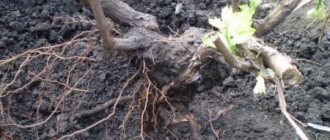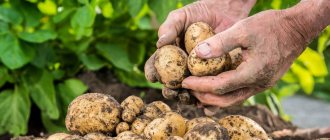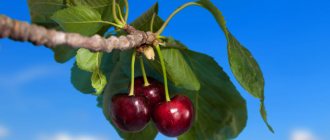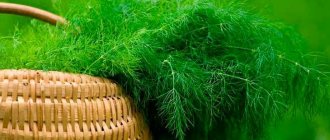How to feed apple trees in spring and autumn so that there is a good harvest will be explained in detail in this article.
The soil on which apple trees have been growing for decades is gradually losing many nutrients. As a result, this negatively affects the quality of the fruit and their quantity. Any culture, including fruit trees, requires regular feeding. Particular attention should be paid to them in the spring, when the plant wakes up and begins to develop. In order not to harm the tree, you should know the main rules for fertilizing.
How to fertilize apple trees: types of fertilizers
To enrich the soil with nutritious vital elements, a whole complex of fertilizers is used, which consists of:
- Organic fertilizers:
- manure- it contains many essential nutrients for fruit trees, and it also improves soil structure and its physical properties;
- humus - this is a well-rotted last year's manure, which has a large amount of nutrients;
- bird droppings - very effective fertilizer, used as a liquid top dressing, quickly absorbed by the root system of the fruit tree;
- compost material, harvested from peat and manure - used to fertilize all vegetation.
- Mineral fertilizers:
- ammonium nitrate- is one of the most effective nitrogen fertilizers used for root feeding;
- urea, or urea - an excellent tool for foliar feeding;
- superphosphates - are used for both spring and autumn fertilization of apple trees;
- potassium sulfate - this is a gentle substance that is used to deliver potassium elements to vegetation, does not contain chlorine compounds, therefore it can be used for spring and summer fertilization;
- with autumn fertilization, you can use potassium salt;
- wood ash - a full replacement for potash and phosphorus fertilizers.
- Microfertilizers - these are the fertilizers that are required for fruit trees in very small quantities: boron, manganese, molybdenum, etc. They are quite important in the absence of any of these elements, most often they are used after prolonged use of mineral fertilizers.
- Bacterial fertilizers - are used to improve the soil structure, as well as to increase fertility. The most famous are nitragin, azotobacterin and phosphorobacterin.
Each of all types of dressings must be applied in a timely manner and in the correct dosages. So, for example, in the first years of life, young apple trees need phosphorus fertilizers, since phosphorus strengthens and develops the root system of the fruit tree.
To obtain a high yield, apple trees require phosphorus, potassium and nitrogen... Moreover, it is recommended to apply nitrogen only during spring feeding, and phosphorus and potash fertilizers during the period of fruit ripening and when preparing the apple tree for winter.
And also in order to prepare the apple tree for winter, after the introduction of autumn feeding it is necessary to protect the apple tree root system from freezing... For this, mulching is used.
Types of fertilizers and features of their application
For normal development and abundant fruiting, a tree needs a large complex of micro and macro elements.
The most important substances for plants are:
- phosphorus - promotes the development and strengthening of the root system, as well as an increase in the number of flowers and ovaries;
- nitrogen - stimulates the growth and development of green mass of shoots and leaves;
- potassium - increases productivity, immunity and winter hardiness.
Fertilizers containing these substances can be organic and inorganic in nature:
| Organic | Inorganic |
|
|
Purchased poultry manure is often enriched with a complex of macro- and microelements. Please note that it contains a particularly high nitrogen content and can harm the roots of the plant.

Many gardeners use compost for organic fertilizing, preparing it from all kinds of plant waste.
The spring feeding of apple trees should be annual rate of nitrogen and 2/3 of the rate of potassium and phosphorus... Further, in the summer, the introduction of nitrogen leads to an excessive build-up of green mass to the detriment of yield, and also worsens the frost resistance of the tree. In addition, the amount of nitrates in fruits increases.
Top dressing with a high content of potassium and phosphorus helps the plant to quickly use up the accumulated nitrogen nitrates.
Potassium chloride and phosphorus agents are more suitable for the summer-autumn period; in the spring, their use in large quantities is undesirable, since they can provoke diseases.
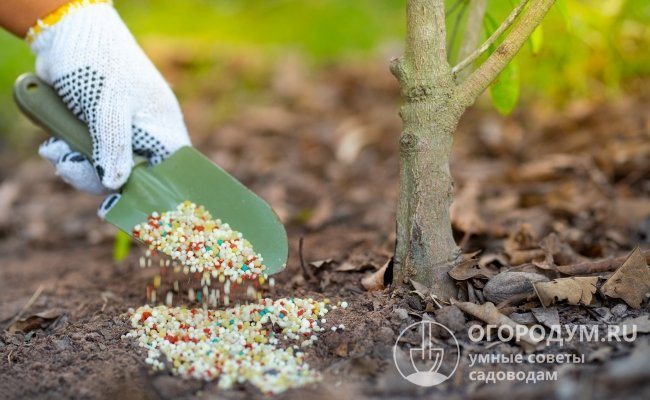

Ready-made complex fertilizers include basic elements in various proportions
The choice of spring feeding also depends on soil type:
- for sandy and sandy loam soils, the introduction of nitrogen or complex nitrogen-containing compounds is mandatory. Humus, mullein, and compost will be helpful;
- nitrogen is introduced into loam and clay soil in moderation, mainly alternating between phosphorus and potassium agents. Compost and mullein help to loosen such soil;
- chernozem is rich in nitrogen, so it can be avoided or minimized from its additional introduction. This type of soil for loosening is mulched with sawdust, sand or peat (the latter is used sparingly so as not to acidify the soil);
- it is advisable to enrich lime soil primarily with potash agents and organic matter.
Bone or dolomite flour is also added to the acidified soil for "alkalinization", and this is best done in the spring. They can be bought ready-made and used as needed.
Norms
If you are using commercially available mineral concentrates, follow the dosages indicated by the manufacturer on the packaging.
For organic products, the norm is 3-8 kg of fertilizer per 1 m2 of the trunk circle, adjusted for the age of the tree and the type of soil. Liquid formulations are made at the rate of 3-4 buckets under a tree.
If you have doubts about the amount of fertilizer needed, it is better to reduce the rate than to exceed it, since the latter is fraught with burns to the roots and diseases of the apple tree.
Mulching apple trees and what is mulching?
After adding all the necessary nutrients to the soil, the tree trunk circle of the apple tree is covered with a layer of mulch. Mulch is a special material that is used to protect the root system from freezing in winter for a longer moisture preservation in the near-trunk circle, suppressing weeds.
As a mulching material, you can use: decorative chips, sawdust, grass cuttings, special covering material, straw.
If you use mowed fresh green mass as a mulching material, then this type of mulching will also serve as an additional top dressing.
Decorative chips are specially formulated organic material sold in stores. Decorative chips are used not only to preserve the root system of the fruit tree, but also to create a beautiful landscape around the apple trees.
It is very important to know which fertilizers and how to apply. The main fertilization methods are root dressing:
- Delivery of nutrients to the tree trunk circle,
- Fertilizer along the perimeter of the tree crown,
- Hole fertilizer for apple trees.
But root feeding of fruit trees is not always effective, since any structureless soil, especially very dry soil, actually blocks the assimilation of all nutrients by the tree.
Very important! All kinds of chemical (mineral) fertilizers, if used incorrectly, often interact with each other.
In this case, improper root dressing can do more harm than good. But do not despair, since there is another, proven over the years, fertilization method - this is foliar feeding.
Nutrient Delivery Methods
It is also important to add useful substances correctly, otherwise the tree will not be able to assimilate them in full. Usually, feeding is carried out by root and foliaralternating them with each other.
Introduction under the roots
Fertilizers enrich the soil in the trunk circle, usually 1-2 m larger than the crown diameter.
Liquid formulations
To avoid spreading, liquid mixtures are introduced into a pre-prepared circular groove... It can be dug with a flat cutter or a hoe. The depth should be up to 40 cm, width - about 30 cm. For dwarf varieties, the grooves are made shallower.
This method is not suitable for columnar apple trees - their roots are close to the surface and can be damaged when digging a ditch.
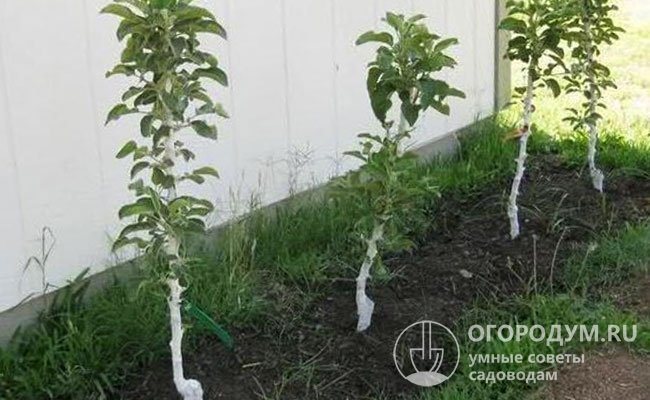

In columnar crop varieties, the root system is located close to the soil surface
Liquid food can also be poured into small wells with a depth of about 50 cm... They are made with a special drill or crowbar at the rate of 2-3 wells per 1 m2.
When preparing nutrient solutions, it is recommended to dissolve dry granular fertilizers in warm water in advance, otherwise they may remain in the sediment. For this purpose, it is advised to use a separate container of small volume.
Before adding liquid formulations, it is advisable to water the apple tree with two or three buckets of clean water so as not to burn the roots.
Dry dressings
One to two hours before the introduction of dry nutrient compositions, the soil is watered abundantly, after which the prepared mixture is scattered around the trunk circle and, if rain is not expected in the near future, it is watered again from above. It is also allowed to incorporate the fertilizer with a rake.
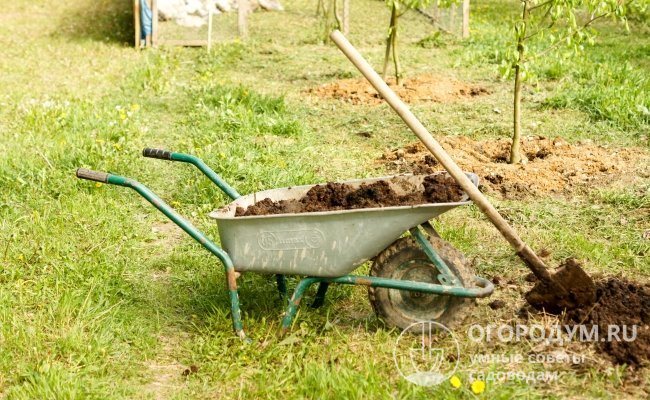

Before using dry fertilizers, the soil under the trees must be well moistened
Some gardeners recommend a focal fertilization scheme: 10-12 pits 30-40 cm deep are made around the crown perimeter, 500 g of superphosphate and potassium sulfate are placed there, and then added dropwise. Such a stock is enough for a tree for 5-7 years.
If you use ammonium nitrate, you also need to dig in it - when it comes into contact with air, it loses some of the nitrogen.
It is important to regularly loosen the soil, otherwise the fertilizer will not be absorbed completely. It is best to use a pitchfork. They are stuck in 20-30 cm, slightly tilted and pulled out without twisting so as not to damage the roots.
Foliar spraying
This type of feeding is used as an additional one. Usually they resort to it if the tree clearly suffers from a lack of certain elements.By the foliar method, useful substances are introduced after the appearance of the leaves.
It is necessary to spray the tree in calm weather in the morning before 6:00 or in the evening after 20:00, otherwise you can burn the leaves. During the day, this procedure should be performed only in cloudy weather, but when rain is not expected.
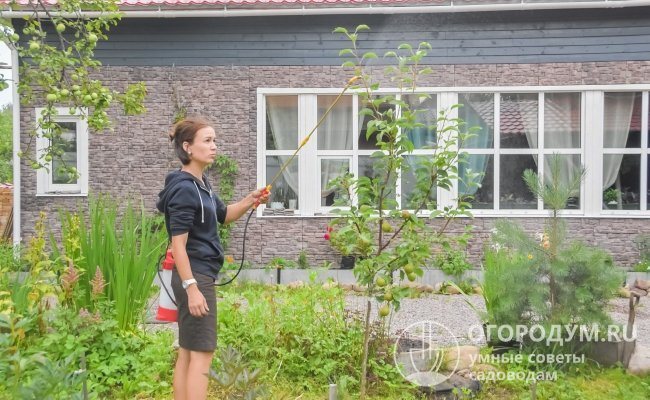

Spraying is carried out in calm cloudy weather
Try the solution on one branch in advance and wait a day. Carry out a full spraying if during this time no negative changes or chemical burns appear. Otherwise, you should reduce the concentration of the composition and try again.
Most often, urea (30 g per 10 l of water) or ash (250 ml per 10 l) is used for foliar dressing. These substances not only strengthen the plant, but also destroy a number of pests.
You can also use purchased preparations (fertilizers containing components in a chelated, that is, easily digestible form, for example, "Plantafid", "AgroMaster" and "Aquarin" are especially good) or prepare complex composition:
- magnesium sulfate 2%;
- zinc sulfate 0.1%;
- iron vitriol 0.1%;
- borax 0.2%;
- manganese sulfate 0.1%;
- copper sulfate 0.05%.
Foliar dressing is often combined with spraying against pests and diseases, but you should make sure that poisons have no contraindications to such mixing. You cannot add liquid fertilizers to the Bordeaux mixture.
Foliar feeding of apple trees
Foliar dressing is a method of fertilizing fruit trees, in which fertilizer is applied not at the root, but on the leaf plates of the tree.
The advantages of this method:
- The leaves are very actively absorb and assimilate nutrients.
- The effect of feeding is visible already on the 3rd day, but it lasts only about three weeks.
- Often, foliar dressing is used in emergency cases, when the tree urgently needs to be given some missing element.
Such feeding it is recommended to carry out regularly (once every three to four weeks), at least 2 times per season:
- The first time, when leaf blades are just beginning to form;
- The second time, when the apple tree is already in bloom and the fruits begin to set.
Consider the issue of choosing trace elements for spraying an apple tree. The first thing to know is that foliar fertilizers should always be water-soluble.
For fertilizing with nitrogen, a 0.3% urea solution is very well suited for young trees, and for an older fruit tree, a 0.5% concentration of urea solution can be used.
For feeding with phosphorus - superphosphate.
Important! Superphosphates are very poorly soluble in water, so it is better to fill it with boiling water. For foliar feeding, dilute it to a concentration of 3%.
For feeding with potassium, a 1% potassium sulfate solution is used. Can also be applied already ready-made complex preparations for foliar feeding, for example, stimovit, which contains phosphorus, potassium, nitrogen, humic substances, as well as trace elements (manganese, zinc, copper).
How to fertilize an apple tree
All fertilizers applied under apple trees can be divided into two groups:
- organic: manure;
- compost;
- biohumus;
- humus;
- bird droppings;
- sapropel.
- nitrogen;
Spring feeding with urea
Urea (carbamide) is nitrogen-containing (46% nitrogen), readily soluble in water. In liquid form, it is very quickly absorbed by plants. It is not necessary to add it to wet soil during rain, the granules will immediately decompose, the nitrogen will evaporate, and the plant will starve.
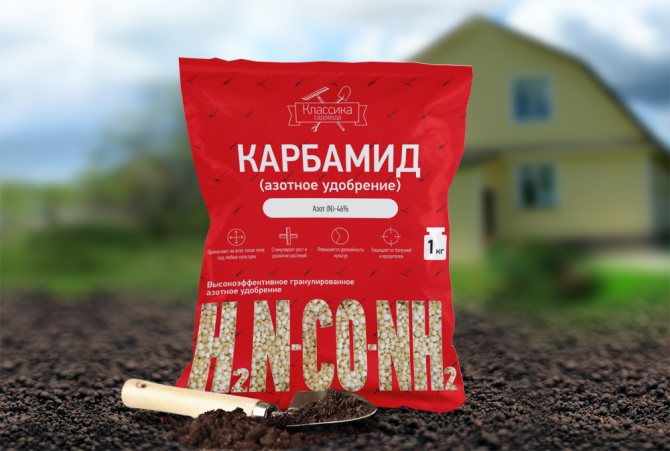

Urea is the main nitrogen mineral fertilizer for apple trees
Under the apple trees, urea is applied from 100 to 250 g, depending on the age and size of the tree.
Simultaneous introduction of urea with:
- wood ash;
- calcium nitrate;
- simple superphosphate;
- lime;
- chalk;
- plaster;
- dolomite flour.
Urea slightly acidifies the soil, and large doses can lead to plant burns and death, as well as to the accumulation of nitrates in the soil.
You can replace urea with other nitrogen-containing drugs: ammonium sulfate and ammonium nitrate.
Fertilizing apple trees with phosphorus
Phosphorus plays an important role in plant life. With its lack, flowering and ripening of fruits are delayed, and the color of the leaves changes from green to purple. This trace element increases the resistance of apple trees to drought and frost. Most often used for feeding:
- superphosphate;
- double superphosphate;
- ammophos;
- diammophos;
- bone meal.
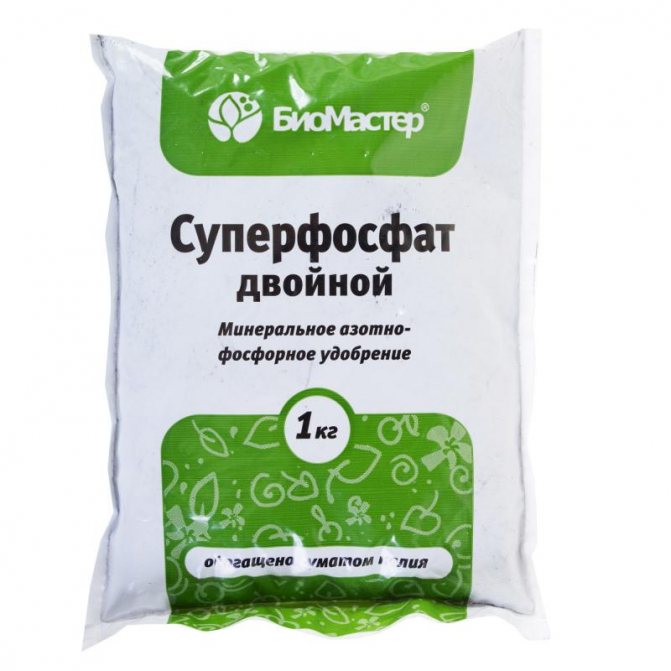

Double superphosphate can be dissolved in sizzling water or embedded in the soil with dry granules
The phosphorus content in superphosphate ranges from 20 to 50%; it is introduced into the soil mainly in the second half of summer and autumn. The application rate is 40-60 grams per 1 m2, it is scattered under the crown or shallowly embedded in the ground.
On acidic soils, phosphorus is not assimilated by plants, therefore, such a soil must be deoxidized before using it.
Superphosphate is poorly soluble in cold water, it is poured with boiling water and kept in a warm place. But even after such treatment, the fertilizer will not dissolve completely, but will be grains, so it needs to be shaken periodically.
Superphosphate cannot be used together with urea or ammonium nitrate.
Potash fertilization
Potassium influences the increase in yield, the taste of apples, the plant's resistance to diseases. Most often, potassium chloride or potassium nitrate is used. These drugs dissolve well in water, but penetrate deep into the soil rather slowly. On sandy soils, the potassium application dose should be increased.
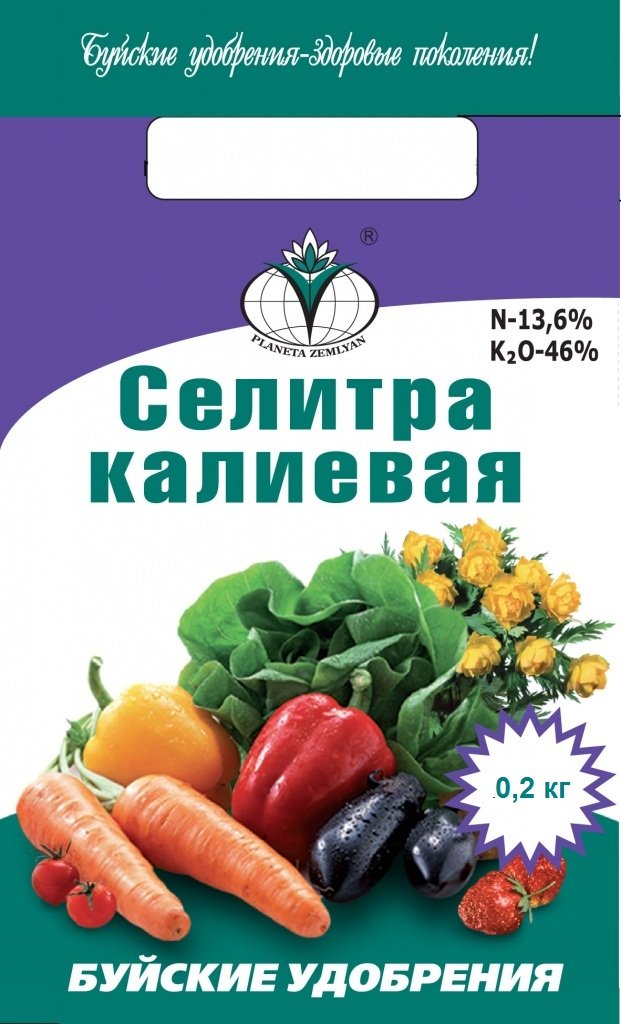

Potassium nitrate is used as a source of potassium
Ash is a good source of potassium, but it cannot be mixed with organic, ammonia, and phosphorus water-soluble fertilizers.
Top dressing with manure
Manure is an excellent organic fertilizer rich in trace elements. Horse manure is considered the most nutritious, cow and pork manure is less useful.
It is good to feed a fresh mullein diluted in water in early spring for the rapid growth of young shoots. Manure piled up in heaps flares up, melts and in a few months turns into nutrient-rich humus. They use it both for spring feeding, making 1-2 buckets under each apple tree, and in the fall, mulching the trunk circles.
Top dressing of apple trees in July with phosphorus-potassium fertilizers
It is recommended to feed apple trees in July during the formation of fruits with fertilizers containing phosphorus and potassium, to improve metabolic processes, the source of energy in which is phosphorus. And also to improve the taste of the future harvest, which is influenced by the elements of potassium.
At this time of the year, it is better to feed the apple tree by the foliar method, spraying leaf plates on both sides.
To preserve moisture and assimilate a large amount of nutrients by leaf plates, this procedure is best done in the early morning or evening. When the sun is not in the active zone and it is desirable that no rain is expected in the next day.
Application rules
Dosage
When feeding a garden, it is important to know the rules and the measure of fertilization. An excess of some minerals interferes with the absorption of others and causes an imbalance in the development of the tree.
Attention! An excess of nitrogen provokes a rapid growth of the leaf mass to the detriment of fruit formation, and a supersaturation with potassium inhibits the growth of shoots and accelerates aging.
The good news is that the amount of fertilizer for each plant can be calculated. On the packaging, manufacturers, as a rule, place information about the dosage per one square meter of soil or one hundred square meters.
To determine the required dosage, you need to calculate the projection area of the crown: it is within these limits that the suction roots of the tree are located. Some gardeners add another 0.5 m to the crown projection. We measure the radius in meters from the trunk to the end of the side branches, square it and multiply by 3.14 (approximate number π). We get the area of the circle that we will fertilize.
You can be guided by the norms of fertilizers based on the age of the tree, given in the table.
| Age | Nitrogen demand (g / m2) | Phosphorus demand (g / sq.m) | Potassium requirement (g / m2) |
| 1 | — | — | — |
| 2 | 35 | 100 | 40 |
| 3-4 | 75 | 125 | 70 |
| 5-6 | 105 | 175 | 95 |
| 7-8 | 140 | 210 | 125 |
| 9-10 | 140 | 250 | 170 |
| After 10 | 140 | 250 | 170 |
Timing
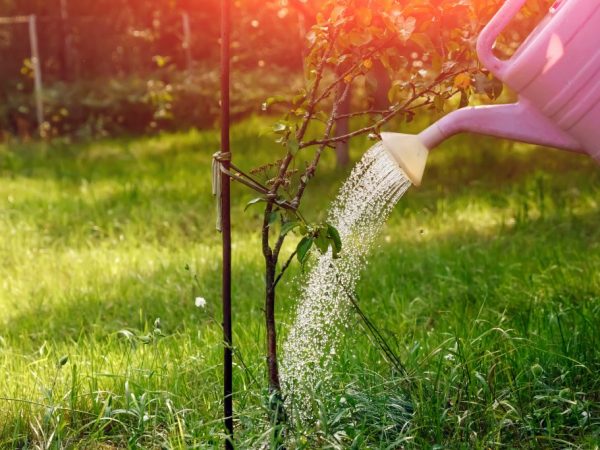

The amount of fertilizer depends on the age of the plant.
In the spring, the apple orchard is fed according to the phenological phases of tree development. According to the rules, there are three stages of application:
- before flowering: early March - early April;
- during flowering: mid-April - early May.
- after flowering: beginning - mid-May.
Before flowering
The first early spring feeding can be done from early March to early April. In different climatic zones, the timing is different, in addition, the spring weather makes adjustments. Blooming buds on the branches of the apple tree serve as a signal for feeding.
During flowering
Apple trees bloom, depending on the region, in late April or early May. The swelling of the pink bud and the opening of the first flowers serve as a guideline for the second feeding. During the budding and flowering period, the main part of the fertilizer is applied.
After flowering
The main purpose of feeding is to maintain the growth of the ovaries. It is carried out when the petals fall from the trees. In most regions, this period is from the first half of May to the end of the month.
How to feed an apple tree in different seasons:
In the spring
As the first spring top dressing, it is best to use fertilizers, which will mainly contain more elements. nitrogenthat will activate vegetation processes in fruit trees. In this case, only the root method of introducing one of the types of nutrients is used:
- Humus - 3-4 buckets per apple tree;
- Ammonium nitrate - 40 grams around the perimeter of the tree crown;
- Urea - 600 grams.
When feeding apple trees in spring, fertilizers should be distributed not near the trunk, but along the perimeter of the crown, that is, at a distance of up to half a meter from the trunk of the apple tree.
In summer
In the summer, all the necessary nutrients are used to improve the vegetation processes of the fruit tree: phosphorus-potassium fertilizers (100 grams of superphosphate + 70 grams of potassium sulfate + 10 liters of water), a solution of chicken manure or slurry, urea (100 grams +10 liters water). Read separately about feeding in August here.
Important! It is best to carry out summer dressing with granular fertilizers or fertilizers in powder form during the rainy season, and use liquid dressings in dry weather.
Autumn and winter
In the autumn, apple trees need organic and mineral fertilizing.to help trees prepare for the coming winter.
Phosphorus and potassium fertilizers (superphosphates, potassium sulfates) are used as mineral fertilizers. In no case should nitrogen-containing substances be used in autumn, as they reduce the winter hardiness of fruit trees.
Most often used as organic humus, peat, composts... It is recommended to apply such fertilizers directly 50 cm from the tree trunk along the entire perimeter of the apple tree crown into the soil structures during digging. Or when forming a hole along the perimeter of the crown, the depth of which should be at least 30-40 cm. In this case, 3-4 buckets of organic fertilizer are used per tree.
The main types of mineral fertilizers
Mineral fertilizers are concentrated dressings that are applied in the spring shortly before planting.
They are:
- simple, consisting of one element (nitrogen, phosphorus, potassium);
- complex, include from two or more components.
The most used fertilizers in this group:
- nitrophoska;
- complex fertilizers (Ammophos, Ammofoska, Nitroammofoska, Diammofoska, etc.);
- ash;
- potash fertilizers;
- nitrogen fertilizers;
- phosphate fertilizers.
Nitrogen
Nitrogen fertilizers have a positive effect on the growth of the plant bush, its speed. It is important to follow the instructions for using nitrogen, since it is easy to overdose this drug, then you will get a large tree and a small harvest. Most often, fertilizer is used during the growth period.
All nitrogen-containing fertilizers are divided into several main groups:
- Nitrate fertilizers. Sodium and calcium nitrate is a prime example of this group.
- Ammonium. Ammonium chloride and ammonium sulfate belong to this category.
- Ammonium nitrate. The most famous representative is ammonium nitrate.
- Amide fertilizers. These include urea.
- Liquid nitrogen fertilizers. Common representatives are ammonia water and anhydrous ammonia.
Nitrogen fertilizers for the apple tree are applied in the spring so that the tree grows a healthy and lush crown. The use of nitrogen-containing fats in summer feeding is also justified, since this stimulates the formation of fruit ovaries.
Excessive doses of nitrogen lead to burns of the rhizome.
For apple trees, strictly according to the instructions, you can use:
- urea;
- ammonium sulfate;
- ammonium, sodium and calcium nitrate.
Potassium
Potash fertilizers are produced at the mines of the same name - these are natural deposits.
These fertilizers are suitable for all types of soil:
- black soil;
- clay soil;
- and even sandstone.
Potassium helps transport sugars through the tissues, thanks to which there is a rich nutrition of plants, the formation of mouth-watering and sweet fruits. It is also responsible for the growth of deciduous mass. If it is found in excess in the soil, then the plants are not susceptible to diseases and pests. Potassium, which entered the soil from fertilizers, is very well absorbed and is used by plants almost completely.
There are several types of simple potash fertilizers:
- Potassium chloride (or potassium chloride) is introduced in the fall.
- Potassium sulfate (potassium sulfate) does not contain harmful impurities in the form of sodium, magnesium and chlorine. Fertilizer is applied to the soil in autumn and spring directly into the hole. It is permissible to combine potassium sulfate with other types of fertilizers, it will not harm the plants.
- Potassium salt is suitable for application to sandy soils, sandy loam, peat soils, since these types of soils suffer from potassium deficiency more often than others. Fertilize the soil with potassium salt in the fall, preferably in the form of the main top dressing.
- Potassium carbonate (potassium carbonate or potash) includes 2 components: potassium chloride and sylvinite.
- Wood ash is a natural, most economical and affordable mineral raw material. Potassium contains only 11%, but it is supplemented by trace elements: calcium, boron, iron, copper and phosphorus and magnesium. Wood ash can be used throughout the planting life. The greatest effect will be made by ash in the spring when planting directly into the holes. In the summer, in the form of mulch after watering, in the fall - for digging the ground.
- Cement dust is a waste product from the production of cement. This supplement does not contain harmful chlorine, and it contains slightly more than 8% potassium. Cement dust is suitable for soils with high acidity, as well as for plants that do not like chlorine. This fertilizer is often mixed with milled peat, in equal parts (1: 1), as this improves its physical properties.
Potassium is especially necessary for young apple trees for good development and growth. For mature trees, potassium stimulates immunity and helps to survive drought in summer, frost in winter. Potassium should be fed to apple trees in the fall, so that by spring this element is completely decomposed in the soil and becomes available.
Recommended potash fertilizers:
- potassium sulfate;
- potassium magnesium;
- potassium salt.
Phosphorus
Phosphate fertilizers - mineral fertilizers, calcium and ammonium salts of phosphoric acid. Phosphorus stimulates full-fledged growth, flowering, development of strong fruits.
The reproductive system suffers most from the lack of phosphorus, it ceases to function, therefore, the reproduction of the plant suffers. Phosphorus is an integral part of DNA and RNA proteins and is found in many substances.
Types of phosphorus fertilizers:
- Water soluble. These fertilizers have a stimulating effect on the development of roots and contribute to their strengthening.
- Citrate and lemon soluble. Bone meal, precipitate, thermophosphate belong to this species.
- Hardly soluble fertilizers. Ammophos, diammophos, phosphate rock, vivianite are the main representatives of this group. These fertilizers can interact with each other. These fertilizers are combined with nitric and sulfuric acids.
- Complex fertilizers are phosphorus-potassium and nitrogen-phosphorus-potassium fertilizers.
Causes of phosphorus deficiency:
- phosphorus belongs to poorly assimilated compounds, the complexes formed are retained in the ground and do not enter the plants;
- intensive farming depletes the soil microflora;
- wrong crop rotation and land cultivation;
- irregular fertilization;
- irregular or sporadic feeding.
The use of industrial fertilizers for the introduction of phosphorus is more expedient than the use of organic matter. Phosphorus deficiency in the apple tree manifests itself in a special dark green color of the leaves with a purple or silver tint on the underside. A simple or double superphosphate is introduced under the apple tree, as well as phosphorite flour - 200 g / 1 m2.
Fertilizing with iron (ferrous sulfate)
Apple trees and pears are the fruit trees that are most susceptible to diseases such as chlorosis. Chlorosis is a lack of iron, which is manifested by the underdevelopment of the leaf plate, that is, green streaks fade on the leaves due to the lack of chlorophyll pigment, which leads to early foliage. And also there is a decrease in yield and underdevelopment of the fruits themselves.
For the prevention and treatment of chlorosis, a remedy such as an aqueous solution of ferrous sulfate is most often used, or, as they say, add iron under the apple tree. At home, it can be prepared according to the following scheme: take a ten-liter bucket of water, add 2 teaspoons of citric acid to it, dissolve well and add one tablespoon of ferrous sulfate.
Spray apple trees with this solution in early spring or late autumn, after the tree has no foliage.
The needs of apple trees
Before purchasing agrochemicals, you need to know the needs of apple trees for microelements. With the arrival of spring, all plants need nitrogenous compounds to build up green mass, but during the period of fruit ovary, nitrogen can be harmful. Because the plant will actively plant greenery instead of producing fruit.
Closer to the beginning of flowering, apple trees need potassium, which provides protein synthesis in tissues. Potassium also increases the resistance of plants to various diseases. Phosphorus is necessary for the formation of the root system, especially for young seedlings. Phosphorus and nitrogen should be applied with the first dose of fertilizer in early spring.
What fertilizers do apple trees like? Both agrochemicals and organics are suitable for them:
- urea;
- ammonium nitrate;
- potassium nitrate;
- nitroammophoska;
- animal fertilizers;
- compost.
When feeding apple trees, you need to strictly adhere to the proportions. For example, an excess of nitrogen will deprive the grower of the crop, since the tree will actively develop green mass and grow new shoots. Exceeding the norm of agrochemicals can destroy the root system - it will "burn".
Without feeding, the apple trees will yield a meager harvest, and the fruits will be small.
It is necessary to introduce agrochemicals into the soil correctly: they are embedded in the near-trunk circle, and then sprinkled with earth. The depth of application is 40-50 cm.
Signs of micronutrient deficiency are as follows:
- lack of nitrogen leads to pale color of leaves, early yellowing and dropping;
- lack of phosphorus affects the size of the deciduous cover and an unnatural green color;
- potassium deficiency leads to an unnaturally bluish color of foliage and crushing of fruits;
- iron deficiency leads to chlorosis;
- zinc deficiency leads to folding of leaves into rosettes;
- with a lack of copper, the leaves become stained and dry out quickly;
- the lack of boron leads to a change in the color of the leaves - they turn yellow, and the veins - red.
In all cases, the lack of trace elements affects the fertility of the tree - apples ripen poorly, become small, their number decreases markedly.


Top dressing with sodium humate
In order to speed up the fruiting processes, increase the immunity of fruit trees and get rid of excess nitrates that accumulate in the fruits, such a universal fertilizer is used, as sodium humate... It is believed that sodium humate helps the fruit ripen on the apple tree.
For spring foliar feeding, it is necessary to dilute 3 grams of sodium humate in ten liters of water. The whole green crown of the tree is sprayed.
Sodium humate contains elements such as nitrogen, potassium, phosphorus, humic acids, as well as a large number of essential trace elements. Spring feeding of apple trees with such a fertilizer will help the apple tree gain strength, strengthen its immune defenses and increase yields.
The purpose of feeding
First of all, the apple tree needs spring feeding to increase the yield. At the same time, the gardener also solves other important tasks:
- gives the tree a supply of nutrients for a quick start;
- enhances the growth and development of shoots;
- provides "bearing" and pouring of fruits;
- strengthens plant immunity to diseases and pests.
When deciding on fertilization, the gardener evaluates many factors:
- Plant age. Young trees with good care (weeding, loosening, mulching, watering) assimilate a sufficient amount of nutrition from the soil and do not always need additional feeding.
- Vegetation phase. In different periods from the awakening of the tree to the picking of fruits, the apple tree needs different substances, so the feeding schemes will be different.
- Soil composition. Chernozem soils do not require fertilization if the garden is young and the apple trees have not depleted the soil. Swampy or, conversely, sandy soils require special attention of the gardener.
- Weather. During the snow melting period or in the presence of precipitation, fertilizers can be applied undissolved. In dry warm weather, only liquid dressings are used.
- Plant health. Some fertilizers can be used to combat fungal and bacterial diseases. In this capacity, spraying of trunks and branches with urea is often used.
- The availability of fertilizers, the scheme of planting and forming apple trees and other individual conditions.
Assessing all the conditions, the gardener must choose the optimal feeding scheme, the method of application and the dosage of fertilizers.
How to feed apple trees with ash?
When preparing fruit trees for the winter period, organic fertilizers such as wood ash, which contains elements that are easily assimilated for the root system of apple trees:
- Phosphorus;
- Potassium;
- Copper;
- Molybdenum;
- Boron;
- Calcium and Manganese.
This fertilizer does not contain chlorine, which is a great advantage over the use of store fertilizers. Ash is introduced before the autumn digging of the soil, in the calculation, one kilogram of ash should be distributed over one square meter.
Important! Despite the content of many useful nutrients in the ash, it must be applied in dosage, in no case should a large amount of this fertilizer be applied.Since wood ash is alkaline, in very large quantities it can be dangerous for earthworms and beneficial microorganisms.
As you can see, feeding ash trees is not so difficult!
Types of dressings
The apple tree reacts well to both mineral components and organic substances.
Organic
- Fresh manure. It is best used for digging an apple tree in spring and autumn. You will need about 10 kg of fertilizer per square meter of land. You can also use mullein during the entire growing season of the apple tree, which is diluted with water in a ratio of 1:10.
- Horse manure (semi-rotten). With such a fertilizer, you need to be careful, since it contains ammonia. The latter, as you know, can harm the root system if applied in large quantities, especially when it comes to young fruit trees (up to the 3rd year after planting). You can get rid of ammonia by letting the manure first lie down for three to seven days. Or, in order not to risk it, use humus.
- Humus. This is organic matter, which consists of rotted remains of animal and plant origin, for example, the same manure. Such fertilizer will no longer damage the apple tree rhizome, so it can be used without fear. The rates of application of the substance under discussion under an apple tree are similar to manure.
- Bird droppings. It is recommended to use dry bird droppings as fertilizer. It is better to apply such a heel during the first spring digging procedure. It is important to remember that this substance contains a large amount of nitrogen. In this regard, it is necessary to carefully apply it in the fall, so as not to activate the rapid growth of green mass, shoots near the tree before winter, as well as in spring, when you can leave burns on the roots of young and still weak trees. As a liquid fertilizer, you can use a solution that includes 15 liters of water and 100 g of poultry droppings. Such a feeding solution should be infused for 6-10 days before use.
- Wood ash. It is an excellent fertilizer for apple trees, as it can deacidify the soil, thereby protecting the tree from insect attacks and damage by rot, fungal diseases. Ash as a fertilizer may well replace purchased potash fertilizers.
- Bone flour. Organic, which contains a large amount of nitrogen and calcium. Many gardeners use it as a soil deoxidizer. A fertilizer such as bone meal has a beneficial effect on the apple tree if it is applied in spring and summer. Today, you can buy ready-made bone meal in any specialty store in powder or liquid form. The dosage is detailed on the packaging of each product.
The application of organic fertilizers for fruit trees is clearly demonstrated in the video:
Minerals
Despite the wide popularity of organic matter as fertilizer, mineral dressings are also often used. Their advantage is that the products are not able to provoke fungal pathologies in apple trees, and also do not contribute to the growth of weeds in the near-stem circle. Of course, where the soil is completely depleted, organic components cannot be dispensed with, but if you learn to harmoniously combine both types of fertilizers, a positive result will not be long in coming.
- Urea. Top dressing with nitrogen content is applied under apple trees in spring. This helps the fruit tree to grow a beautiful, healthy and lush crown. Also, some gardeners apply nitrogen-containing fertilizers in the summer, thus provoking the active formation of fruit ovaries. It should be understood that the lack of nitrogen will affect the apple tree foliage, which will gradually turn yellow and fall off. But an excess of the substance will negatively affect the quality characteristics of the fruits and yield in general.
- Phosphorus (Simple Superphosphate). Experienced gardeners know that phosphorus in the amount required by the apple tree is not present in almost any organic fertilizer. And without it, the tree will not be able to fully assimilate nitrogen. In this regard, it is recommended to jointly apply phosphorus and fertilizers of organic origin under the apple tree. This substance helps to improve the development of the root system of fruit crops, as well as to accelerate flowering and, accordingly, fruiting.
- Potassium. It is especially important for young apple trees for proper growth and development. For mature trees, this substance is also very useful, as it helps to more easily endure summer droughts, as well as winter frosts. It is best to add potassium under the tree in the fall, then by the spring it will fully dissolve in the soil and begin to work. Gardeners recommend such potash fertilizers: potassium salt, potassium sulfate, potassium magnesium.
It is permissible for a wave to introduce into the soil the main components discussed above. But the combination of mineral and organic fertilizers will be more effective.
BioGrow biofertilizer is an effective universal top dressing. It is widely known among experienced gardeners and has many positive reviews. The product allows you to increase yields by 50%, protect plants from pests and diseases, and accelerate germination.
You can read more about BioGrow HERE.


Potash fertilizers for apple trees
Another versatile fertilizer is Potassium Sulfate, which is rich in elements such as calcium, potassium, magnesium and sulfur. This fertilizer has a beneficial effect on the growth and development of fruit crops, improves the palatability of the fruit. It can be used as a top dressing regardless of the season, but most often it is introduced in the fall.
A small amount of granular fertilizer is evenly distributed around the perimeter of the apple tree trunk circle at a distance of 15-20 cm from the trunk.
More precise dosages are detailed in the instructions for use. Potash preparations increase winter hardiness and improve soil structure, making them more fertile, which leads to an increase in yield and taste of fruits.
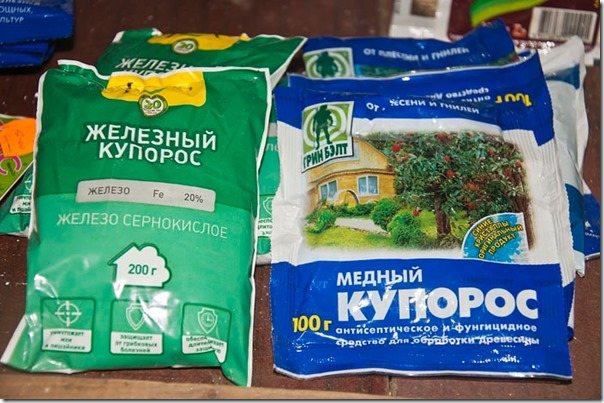

Iron and copper sulfate.


Sodium humate.


Siderata.
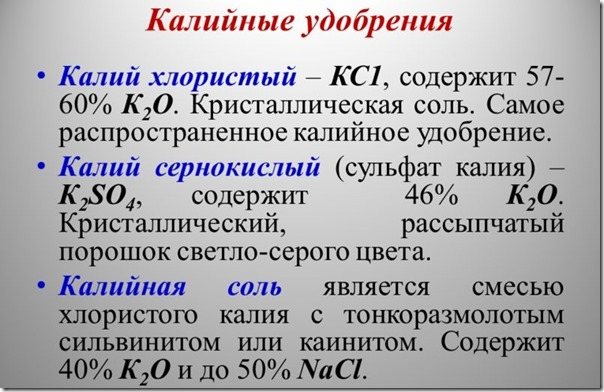

Potash fertilizers
Features of feeding trees of different ages
Top dressing of trees in spring also depends on the age of the plants. The main task of young seedlings is to take root in a new place and start developing as quickly as possible. Fruiting during this period is not the main goal. According to experienced gardeners, after planting, it is best to use AgroProstrost fertilizer, which will give the young seedling all the trace elements necessary for its rooting and growth (nitrogen, potassium, zinc, magnesium). This is especially important if your site is characterized not by black soil, but by clay or sandy soil, there is a lack of all nutrients.
The first feeding is carried out by adding a dry additive to the prepared holes. The next addition is usually done in the fall. Starting from the fifth year of life, fruit trees need to be transferred to "adult" feeding, mineral fertilizers should be applied.
For 1 sq. m of area you need to make:
- 15-20 g nitrogen;
- 10 g phosphorus;
- 20 g of potassium.
These substances must be applied in early spring under the snow. A little later, when the earth warms up, you can add "organic". Every two years, about 6 liters of manure is applied under each tree for each square meter of a free circle. In the spring, after the onset of the ovary appearance phase, you can use crushed bird droppings.
In order for the feeding of fruit trees to be as successful as possible, you need:
- Use liquid fertilizers.
- Fertilizing seedlings should be carried out only after rooting in a new place.
- To carry out work in the evening, or early in the morning (and it is better to wait for cloudy weather).
- Apply dry fertilizers either before watering the tree, or immediately after it (an exception to the rule is the application of fertilizers over melting snow, which is carried out in early spring).
- When applying liquid fertilizers, water the soil a little, which will reduce the risk of root burns.
Top dressing of trees up to 3 years
In spring, a young apple tree is fertilized superficially, over the area of the trunk circle, followed by shallow embedding in the soil (loosening with a rake).
Top dressing of trees throughout the year consists of the following stages:
- In early spring. As soon as the soil dries out enough, the near-trunk circles are dug up with a pitchfork, and the strips - with a walk-behind tractor to a depth of no more than 12 cm, together with mulch. If it is problematic to find mulch, then synthetic nitrogen compounds must be added.
- In the summer, feeding is done before the young apples reach the size of a hen's egg. It is better to do this in July, because at this time, nitrogen accounts for 1/3.
- In autumn, before the active yellowing begins, a young apple orchard needs a sufficient amount of phosphorus, magnesium and potassium compounds. They will provide apple trees with overwintering without freezing and frost breaks.
Top dressing of trees over 3 years old
After the formation of the root system, it is better to apply phosphorus, potassium and organic preparations deeper, closer to the roots.
There are two ways to do this:
- In grooves 40 cm deep, 25-30 cm wide, dug over the area of the trunk circle. Top dressing is poured into prepared grooves and sprinkled with earth. It is better to use dry fertilizers.
- In wells with a depth of 40-50 cm, which can be made with a crowbar or a special drill. Wells will need about 2-3 pcs per 1 sq. m. For this method of introduction, it is better to prepare a solution.
What to consider when feeding fruit trees
Plants, like all living things, need care: feeding, pruning, and treatment. But it is impossible to act according to the same scheme in different periods, with different cultures, in different natural conditions. When choosing the best way to fertilize garden trees, take into account:
- the type and age of the fruit tree (in our case, apple or pear);
- type of soil (clay, sandy, sandy loam, loamy, calcareous, peat, black earth);
- soil condition (structure, moisture capacity, pollution, fertility, depletion),
- climatic conditions (average annual temperatures, precipitation);
- type of fertilizer (organic, mineral, trace elements);
- the last feeding (when and with what they were fed, how and in what quantity were fertilizers applied).
The main plan for feeding an apple orchard
The main source of nutrients for plant organisms are natural deposits of mineral components in soil and water sources. And the apple tree seeks out nutrients in exactly the same way.
However, in the spring period of time, when the inclusion of foliage into the active phase of foliage growth after winter rest is noted in a fruit tree, a lack of mineral components is often noted. As a result, there appears need for additional feeding.
Add minerals in three steps. In its most general form, the plan for feeding an apple orchard can be presented as follows:
- first action: performed before the start of the appearance of flowers until mid-March;
- second action: carried out during the flowering period until mid-April;
- third action: carried out until mid-May.
It must be understood that the above fertilization dates in the spring are pretty rough... It is required to specify the extreme time when it is necessary to fertilize depending on the specific climatic and geographical conditions of the area in which the apple trees are located.
All three actions include feeding not only apple plantings, but also around apple soil up to a quarter of a meter in diameter. However, here excessiveness should not be allowed: Introducing an excessive amount of minerals seems to be as dangerous as insufficient feeding of apple trees.
This rule is especially true for plantings of young apple trees: if there are too many mineral fertilizers, the gardener runs the risk of growing a large apple tree with an excessive number of branches, which are unlikely to have a lot of fruits.
Now it's time to consider in more detail the sequence of actions for feeding the apple tree.
Top dressing of apple trees before the flowers begin to appear
The first dose of mineral fertilizers must be taken before the time when leaves and flowers appear in the apple orchard. That is, it is required to feed directly at the moment the first signs of awakening appear in apple trees and pears.
This step is carried out exclusively root feeding... Mainly nitrogen-containing components are used, because they are able to activate the vegetation process in the plantings.
The following substances are best suited as an initial spring fertilizer:
- Ammonium nitrate. Here it is necessary to take into account the age of the trees due to the fact that the introduction of this substance is determined by it: when there are mature plantations, to feed one plant, it is required to add and stir 40 grams of ammonium nitrate in 10 liters of pure water. If the apple tree is relatively old, 20 grams of such a substance will suffice. For preliminary spring feeding, it is desirable to use this saltpeter with the presence of 35% nitrogen compounds. In this case, the percentage by volume nitrogen content can be viewed on the fertilizer package, written as an N symbol.
- Potassium sulfate. It is used for old and old plantations. To prepare feeding for apple trees, you need to stir in 5 liters of purified water up to 5 grams of dry potassium sulfate.
- Ammonium sulfate. When a mineral substance is used simultaneously with the above-mentioned nitrogen-containing components, it is used in a ratio of 15 grams of dry ammonium sulfate to 5 liters of pure water. In the case when this substance is the main means for feeding an apple orchard, its mass must be increased so that it is used in a ratio of 25 grams of dry ammonium sulfate per 5 liters of clean water.
Joint feeding for apples, pears, cherries and currants
For almost all fruit trees, the feeding scheme looks the same. Top dressing for apple and pear in spring includes the same fertilizers in the form of superphosphates, nitrate, urea and ash. For cherries, when preparing mixtures, you should adhere to the ratio of nitrogen / phosphorus / potassium - 3: 1: 4.
In the spring, fertilizing is also mandatory for fruit and berry bushes. Potassium nitrate, urea with ash, manure humus are suitable for them.
The frequency of feeding in these crops coincides with the apple scheme: during flowering, during fruit setting, before wintering.
Attention! According to the advice of seasoned gardeners, the listed trees and shrubs should not be grown in the garden next to the apple trees. This will lead to inhibition of growth and a lack of yield.
Summing up, we can say that feeding apple trees directly affects the quality and quantity of the crop. You need to stick to your fertilization plan for nutrition to be effective. Each feeding should be accompanied by abundant watering, and its composition should correspond to the vegetative state of the plant.
How to combine watering with top dressing?
Watering is one of the most important agrotechnical measures for caring for fruit trees. Even inexperienced gardeners do not need to be taught how important moisture is to plants. No less important is also the introduction of fertilizers, those nutrients, without which no fruit tree will bring good yields and develop well. When caring for trees in the garden, watering and feeding can and should be combined. You will get great results.Let us consider in more detail the issues of watering and feeding apple and pear trees.
In late April - early May, fertilizers are applied to the trunk circles (150-200 grams of urea or 4-5 buckets of humus are scattered near each tree). This is followed by regular watering and root (application of fertilizers directly to the root growth zone) top dressing.
Pears and apple trees need plenty of water at an early age, especially between May and June. For the entire growing season (the period of tree growth from spring to autumn), the usual number of waterings is 4-5 times.
After the trees have faded, it is necessary to replenish stocks of nitrogen in the near-trunk strips. Fertilizers can be effectively applied in the following way. Excavate or loosen a near-trunk strip 1-1.5 meters wide by 8-10 cm deep and shed 1/3 of the amount of water that is intended for irrigation. Calculating how much water your tree needs is very simple. You need to proceed from the age of the tree. Take 20 liters of water every year, but not more than 100 liters. In a dry season, add vinegar to the water at the rate of 1 liter of 9% vinegar per 30 liters of water, so the plant tolerates drought easier.
It is just as easy to calculate amount of nitrogen fertilizers... For each year, 20 grams is taken, if the trees are mature, then the full measure is not more than 200 grams per tree.
By the way, water for irrigation must be warmed up, this is important! As soon as 1/3 of the water is absorbed, nitrogen-containing fertilizer is applied along the entire perimeter of the trunk circle, and the remaining 2/3 of the water volume is topped up. Pour water in such a way that it does not erode the root system and does not go beyond the limits of the near-trunk circle (this is why a loose roller around is important). When the moisture is absorbed, replace or level the soil and mulch the tree trunk with sawdust or cut grass. Thus, you will keep moisture and a comfortable temperature in the root zone longer, which is important for the assimilation of fertilizers as well. It is not necessary to exceed the water consumption, otherwise the moisture along with the fertilizers will leave the root zone, and your efforts will be in vain.
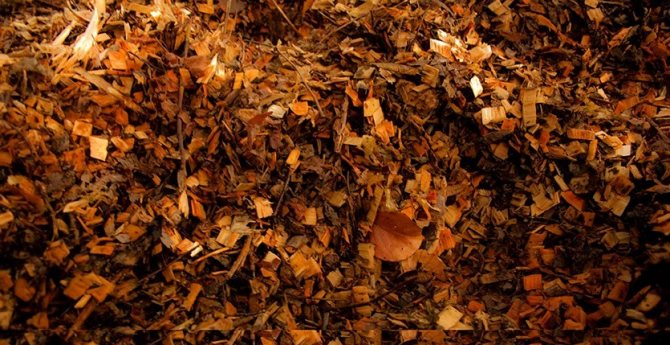

When fruit trees form an ovary, the roots waste a huge amount of nutrients. And here is the time to make one more top dressing, identical to the first one. This feeding is necessary for the ovaries, ensuring their subsequent growth, as well as the growth of shoots and foliage. The best period for this is the end of June.
At the end of June - July, the amount of water in the soil decreases significantly, and the activity of the root system of trees decreases. During this period, the trees are busy with increasing harvest volumes and comes time for the third feeding. You just need to remember that there is also the maturation of shoots and vegetative buds, and the formation of flower buds. This means that the need for the composition of the top dressing is also changing. Fertilizers are applied consisting mainly of phosphorus and potassium. The rate of phosphorus fertilizers is 25 grams for each year of the tree's life (no more than 250 grams per tree), and potash fertilizers 20 grams (no more than 200 grams per tree).
Very important autumn watering of trees. This is especially important in those seasons when summer and autumn were dry and after them trees can be severely damaged by frost. Watering in the fall will not only provide the necessary moisture reserve in the soil, but will also help to effectively absorb nutrients that the suction roots "drink" until the soil freezes.
Watering is naturally combined with loosening the soil in the trunks. But it is possible to loosen the soil more often, up to 6-7 times during the growing season to a depth of up to 10 cm. Lack of oxygen in the root layer of the soil can lead to impaired growth of the roots itself and the aerial part of the tree, impaired absorption of minerals and impaired photosynthesis. Lack of oxygen is especially harmful to young trees when they are actively growing and forming. With loosening, do weeding together, remove all weeds.
Do not neglect watering, especially during dry seasons. If adult pears cope with the task of finding moisture thanks to their powerful root system, then apple trees may suffer.
No related posts
When to fertilize fruit trees
Apples and pears do not have enough "feeding" only in the spring. Fertilization of trees should be done at least three times a year. Top dressing can be root and foliar. With root fertilization, manure or a specially prepared solution is poured under the trunk so that all trace elements are absorbed into the soil and reach the root system. Foliar dressing is the usual spraying of the ground part of the tree.
Root nutrition is most necessary for apple trees in spring, it consists of 3 stages:
- End of March - beginning of April. The main rule of the first feeding is that it must be completed before spring pruning. Pruning in spring is necessary because old branches take away the vitality of the tree.
- Flowering period. At this time, the apple tree needs a lot of moisture, so experts recommend using fertilizers diluted in water.
- After flowering. Before the start of pouring the fruits of the pear and apple trees, they are fed a third time.
Some gardeners strongly recommend making the fourth apple feed. This should be done in the fall, after harvest. Determine the consistency of the food by the weather: if it's rainy autumn, use dry food. If there is not enough moisture, dilute the fertilizer with water.
October
Fertilizers are no longer directly applied in October. However, mid-autumn is the optimal time for water-charging irrigation, and after that, mulching the tree-trunk circles with humus or compost. In the spring, when the snow melts, this mulch will serve as additional nutrition.


*** And of course, do not forget about such an important indicator as soil acidity. If the soil in your area has a pH below 6 units, be sure to deoxidize the soil. How to do it correctly, read our article Soil acidity: determine and regulate.
Fertilizers for a planting pit under an apple tree
When preparing a planting pit, gardeners bring in:
- ash - about 2 glasses or 10 g of potash fertilizers;
- superphosphate - 20 g;
- ammonium nitrate - 5-10 g / m².
If organic fertilizers are introduced into the pit (rotted manure, droppings), then inorganic fertilizer with a high nitrogen content is not needed. Phosphorus is released very slowly, so it must be added. Potassium is required for cell-to-cell metabolism, so it will always be useful when planting.
Important! When planting trees in the fall, fertilizing is not carried out.
If you have a question whether manure can be applied, then you should pay attention to the quality of this substance. Fresh manure is a source of active chemical reactions. When used, the roots of the seedling will burn. Therefore, manure must be aged for at least six months before it can be applied as fertilizer. The same applies to chicken droppings.



